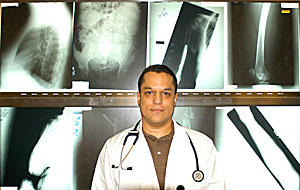 |
|
Jacob Konst/Arizona Daily Wildcat
|
Alexander Fernandez, a third-year medical student currently on his psychiatry clerkship, stands before a series of X-rays in University Medical Center yesterday afternoon.
|
|
|
By Cassie Blombaum
Arizona Daily Wildcat
Wednesday, October 5, 2005
Print this
The UA and its College of Medicine were ranked at the top among the nation's best schools when it comes to Hispanic outreach, a recognition that reflects the university's aim to increase diversity on campus, officials said.
The College of Medicine ranked No. 7 among the nation's medical schools for Hispanic students, according to Hispanic Business Magazine.
Mike Caplinger, a research supervisor with Hispanic Business Magazine, said there were five criteria used to rate the schools, like comparing the number of Hispanic students enrolled in the program, the number of Hispanics on the faculty and the services provided for Hispanic students.
The schools were also rated for the way in which they attract Hispanic students and what they do to keep those students in the university.
The College of Medicine was chosen because of its reputation for diversity, Caplinger said.
But this recognition is nothing new for the college.
The College of Medicine is usually at the top when it comes to Hispanic diversity, said Linda Don, director of minority affairs for the Arizona Health Sciences Center.
"There are 126 medical schools in the country, and we have been listed in past years in the top 10," Don said.
The percentage of Hispanic students at the College of Medicine is consistently around 10 percent, said Jonathan Robles, the director of the Arizona Hispanic Center of Excellence and the director of the office of minority affairs at the Phoenix chapter of the UA College of Medicine.
The number of Hispanic students must remain relatively high because the College of Medicine is a member of the Hispanic Serving Health Profession Schools Inc., a nonprofit organization aimed at improving the health of Hispanics.
"In order to belong to that membership we have to have over 9 percent (Hispanics)," Robles said.
Keith Joiner, dean of the College of Medicine, said the ranking is a reflection of all the hard work that has been done by the college to provide a diverse environment.
"What I think it mostly represents is recognition for all the hard work we've done here," Joiner said.
The Hispanic student population in the College of Medicine changes from year to year, but the average for the past 10 years is about 13 percent, Joiner said.
The average Hispanic faculty and staff has been about 6 percent for the past 10 years, Joiner said.
Although there is room for improvement, a lot of time and money goes into maintaining the diverse atmosphere the college already has, Joiner said.
"We're talking about millions of dollars when this is added up, at a minimum," Joiner sad.
With this money, the college funds organizations like the pre-health professional club, Fostering and Achieving Cultural Equity and Sensitivity in the Health Professions, which is an internship program that provides pre-health undergraduate students with clinical experience, Robles said.
The College of Medicine also works to help Hispanic students early on by establishing career days at local high schools and by offering Med-Start, a program that encourages high school students to consider careers in health, Don said.
"We are providing academic enrichment for students so that they can become stronger applicants," Don said.
Funding generally comes from federal grants, scholarships, the College of Medicine itself and various outside agencies, Joiner said.
Jacob Walsh, a first-year Hispanic medical student, said the UA College of Medicine deserved the high ranking.
"They devote tons and tons of time and the amount of resources that they have here devoted solely to Hispanic students, like the Hispanic Center of Excellence which provides all kinds of different outreach programs for medical students," Walsh said. "I think it is pretty outstanding."
And it's not just the College of Medicine that has received recognition for numbers of Hispanic students.
The UA itself was ranked 16th among the nation's top 100 colleges and universities in awarding bachelor's degrees to Hispanic students for the 2004 academic year, according to Hispanic Outlook Magazine.
The UA awarded 804 bachelor's degrees to Hispanic students last year, according to Hispanic Outlook Magazine.
Arizona State University at the Tempe campus ranked No. 20 and awarded 724 bachelor's degrees to Hispanic students last year, according to Hispanic Outlook Magazine.
Hispanics make up 16.1 percent of the 28,368 undergraduate students at the UA, according to the Diversity Action Plan Progress Report.
The Diversity Action Plan outlines 87 different recommendations in order to achieve the UA's goals of creating a more diverse faculty and student population.
Edith Auslander, vice president and senior associate to the president and Diversity Coalition chairwoman, said increasing Hispanic diversity within the UA is necessary to reflect the state's population.
"More and more, Hispanics are making up a larger part of the population," Auslander said. "We are going to educate a good number of Hispanic students because it's a large proportion of students in Arizona."
Even though the university received positive recognition regarding diversity, the UA can always improve, said President Peter Likins in an e-mail.
"We must build on this success, increasing numbers among Hispanics, African-Americans, Native Americans and Asian Americans," Likins said.
